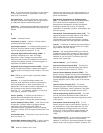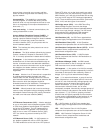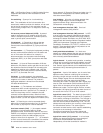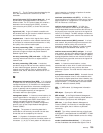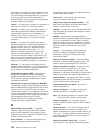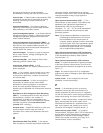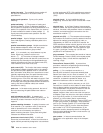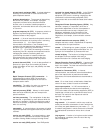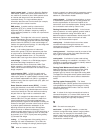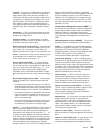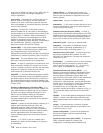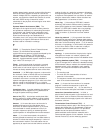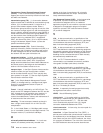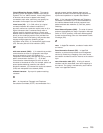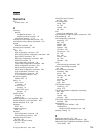rlogin (remote login). A service, offered by Berkeley
UNIX-based systems, that allows authorized users of
one machine to connect to other UNIX systems across
an internet and interact as if their terminals were
connected directly. The rlogin software passes
information about the user’s environment (for example,
terminal type) to the remote machine.
RNR packet. A packet used by a data terminal
equipment (DTE) or by a data circuit-terminating
equipment (DCE) to indicate a temporary inability to
accept additional packets for a virtual call or permanent
virtual circuit.
root bridge. The bridge that is the root of a spanning
tree formed between other active bridges in the bridging
network. The root bridge originates and transmits bridge
protocol data units (BPDUs) to other active bridges to
maintain the spanning tree topology. It is the bridge with
the highest priority in the network.
route. (1) An ordered sequence of nodes and
transmission groups (TGs) that represent a path from
an origin node to a destination node traversed by the
traffic exchanged between them. (2) The path that
network traffic uses to get from source to destination.
route bridge. A function of an IBM bridge program
that allows two bridge computers to use a
telecommunication link to connect two LANs. Each
bridge computer is connected directly to one of the
LANs, and the telecommunication link connects the two
bridge computers.
route extension (REX). In SNA, the path control
network components, including a peripheral link, that
make up the portion of a path between a subarea node
and a network addressable unit (NAU) in an adjacent
peripheral node. See also
explicit route (ER)
,
path
, and
virtual route (VR)
.
Route Selection control vector (RSCV). A control
vector that describes a route within an APPN network.
The RSCV consists of an ordered sequence of control
vectors that identify the TGs and nodes that make up
the path from an origin node to a destination node.
router. (1) A computer that determines the path of
network traffic flow. The path selection is made from
several paths based on information obtained from
specific protocols, algorithms that attempt to identify the
shortest or best path, and other criteria such as metrics
or protocol-specific destination addresses. (2) An
attaching device that connects two LAN segments,
which use similar or different architectures, at the
reference model network layer. (3) In OSI terminology, a
function that determines a path by which an entity can
be reached. (4) In TCP/IP, synonymous with
gateway
.
(5) Contrast with
bridge
.
routing. (1) The assignment of the path by which a
message is to reach its destination. (2) In SNA, the
forwarding of a message unit along a particular path
through a network, as determined by parameters carried
in the message unit, such as the destination network
address in a transmission header.
routing domain. In Internet communications, a group
of intermediate systems that use a routing protocol so
that the representation of the overall network is the
same within each intermediate system. Routing domains
are connected to each other by exterior links.
Routing Information Protocol (RIP). In the Internet
suite of protocols, an interior gateway protocol used to
exchange intradomain routing information and to
determine optimum routes between internet hosts. RIP
determines optimum routes on the basis of route
metrics, not link transmission speed.
routing loop. A situation that occurs when routers
circulate information among themselves until
convergence occurs or until the networks involved are
considered unreachable.
routing protocol. A technique used by a router to find
other routers and to remain up to date about the best
way to get to reachable networks.
routing table. A collection of routes used to direct
datagram forwarding or to establish a connection. The
information is passed among routers to identify network
topology and destination feasibility.
Routing Table Maintenance Protocol (RTMP). In
AppleTalk networks, a protocol that provides routing
information generation and maintenance on the
transport layer by means of the AppleTalk routing table.
The AppleTalk routing table directs packet transmission
through the internet from source socket to destination
socket.
RouTing update Protocol (RTP). The VIrtual
NEtworking System (VINES) protocol that maintains the
routing database and allows the exchange of routing
information between VINES nodes. See also
Internet
Control Protocol (ICP)
.
rsh. A variant of the rlogin command that invokes a
command interpreter on a remote UNIX machine and
passes the command-line arguments to the command
interpreter, skipping the login step completely.
S
SAP. See service access point.
seed router. In AppleTalk networks, a router that
maintains configuration data (network range numbers
and zone lists, for example) for the network. Each
network must have at least one seed router. The seed
router must be initially set up using the configurator tool.
Contrast with
nonseed router
.
708 MRS V3.2 Software User’s Guide



